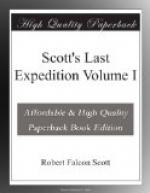Bowers reported a floe of 12 square miles in the middle watch. We made very fair progress during the night, and an excellent run in the morning watch. Before eight a moderate breeze sprang up from the west and the ice began to close. We have worked our way a mile or two on since, but with much difficulty, so that we have now decided to bank fires and wait for the ice to open again; meanwhile we shall sound and get a haul with tow nets. I’m afraid we are still a long way from the open water; the floes are large, and where we have stopped they seem to be such as must have been formed early last winter. The signs of pressure have increased again. Bergs were very scarce last night, but there are several around us to-day. One has a number of big humps on top. It is curious to think how these big blocks became perched so high. I imagine the berg must have been calved from a region of hard pressure ridges. [Later] This is a mistake—on closer inspection it is quite clear that the berg has tilted and that a great part of the upper strata, probably 20 feet deep, has slipped off, leaving the humps as islands on top.
It looks as though we must exercise patience again; progress is more difficult than in the worst of our experiences yesterday, but the outlook is very much brighter. This morning there were many dark shades of open water sky to the south; the westerly wind ruffling the water makes these cloud shadows very dark.
The barometer has been very steady for several days and we ought to have fine weather: this morning a lot of low cloud came from the S.W., at one time low enough to become fog—the clouds are rising and dissipating, and we have almost a clear blue sky with sunshine.
Evening.—The wind has gone from west to W.S.W. and still blows nearly force 6. We are lying very comfortably alongside a floe with open water to windward for 200 or 300 yards. The sky has been clear most of the day, fragments of low stratus occasionally hurry across the sky and a light cirrus is moving with some speed. Evidently it is blowing hard in the upper current. The ice has closed—I trust it will open well when the wind lets up. There is a lot of open water behind us. The berg described this morning has been circling round us, passing within 800 yards; the bearing and distance have altered so un-uniformly that it is evident that the differential movement between the surface water and the berg-driving layers (from 100 to 200 metres down) is very irregular. We had several hours on the floe practising ski running, and thus got some welcome exercise. Coal is now the great anxiety—we are making terrible inroads on our supply—we have come 240 miles since we first entered the pack streams.
The sounding to-day gave 1804 fathoms—the water bottle didn’t work, but temperatures were got at 1300 and bottom.
The temperature was down to 20 deg. last night and kept 2 or 3 degrees below freezing all day.




